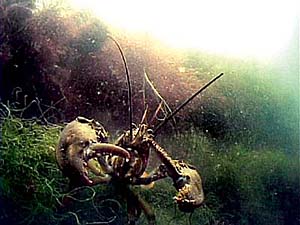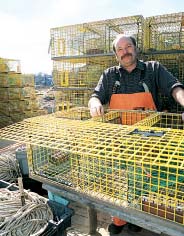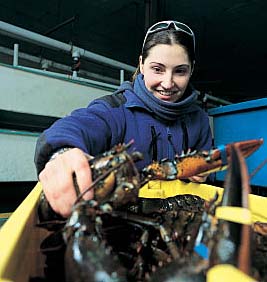 |
 |
| current issue |  |
past issues |  |
send a letter/news |  |
address update |  |
advertise |  |
about us |  |
alumni home |
Features
Crustaceans with AttitudePage 2 of 3
 Courtesy of Darren Scopel |
Watson's lab work on sensitivity to salinity, combined with field work in New Hampshire's Great Bay, has helped fit one piece into the lobster-population puzzle, demonstrating for the first time that lobsters will migrate according to gradients in salinity. Watson has also collaborated with Diane Cowan, senior scientist at Maine's Lobster Conservancy, in a major study of lobster migration patterns. With the help of several lobstermen, the researchers are tracking lobsters with ultrasonic devices. So far the research indicates that there may be three types of lobsters: homebodies who spend months at a time in one harbor, regional travelers who stay within a radius of 20 miles, and long-distance lobsters who in winter may travel 100 miles or more to warmer waters off the continental shelf, returning home for breeding in the summer.
Watson has constructed a sort of lobster corral, dubbed the Lobster Ponderosa, to study another type of lobster movement: their ability to repeatedly return to one shelter. Roughly half the size of a football field, this underwater enclosure is located just offshore in New Castle, N.H. By tracking their movements, Watson has been the first to verify lobsters' homing behavior. He and Scopel have also developed a maze to study whether lobsters can recognize, and remember, left from right.
Down in the Ponderosa, lobsters have given further evidence of their abilities. After being handled by a diver, a lobster typically takes a mile-long hike, and in the corral, they head southeast toward deeper, safer waters. But how do the lobsters know which way is southeast? Are they, like spiny lobsters, able to sense the earth's magnetic field? Or are they, like desert ants, able to remember routes previously traversed?
When he is attaching sonar tags, Scopel often takes time to observe the lobsters. When two lobsters approach each other, they raise up their claws and start sparring. The larger lobster prevails, and the loser suddenly vanishes in a cloud of underwater dust, swimming in the only way it can: plunging backward away from danger with a powerful thrust of its tail. In the future, the smaller lobster will deferentially give the winner a wide berth. Between two lobsters of the same size, Scopel says, the one with the most "attitude" wins.
Lobstering, supersized
 "I don't eat lobster at all," says Dan Millar '78. "My wife got to the point where she said, 'Don't bring any home unless I ask you to.'" Photo by George Barker |
Lobstermen come in two varieties. The vast majority of New England lobstermen stay within 40 miles of land and return to port at the end of the day. In Maine alone, there are roughly 5,000 of these inshore lobstermen at work. The offshore lobsterman is a much rarer breed that can be found south of Maine, fishing the deep-sea canyons at the edge of the continental shelf, more than 100 miles out and up to 1,200 feet down. This is lobstering writ large, with bigger boats, bigger lobsters, bigger profits -- and bigger risks at sea. In wintertime, for example, ice on the rigging can capsize a boat.
Several offshore lobstermen have helped UNH scientists study the size at which lobsters in different geographical areas reach sexual maturity -- a critical piece of the puzzle for determining when a lobster should be considered legal.
 Hummers: Why does one out of 10 lobsters hum when handled? Graduate student Heidi Pye has learned that larger lobsters are more likely to hum, and that crooning makes other lobsters' hearts skip a beat. Photo by Lisa Nugent |
Whether inshore or offshore, the lobstering routine is much the same. The captain retrieves each lobster from the trap and measures the carapace, or top half of its "armor," with a metal gauge to see if it's of legal size (currently 3.5 inches). Maine lobstermen must throw back anything with a carapace longer than five inches, but for offshore lobstermen, there is no upper size limit. The largest lobster ever caught weighed more than 45 pounds.
Virtually every lobster that comes up takes a final stand in the lobsterman's hand, flipping its strong tail in an attempt to backpedal into the ocean, or drawing up its chest and claws like Popeye-on-spinach in a threatening posture called the Meral spread. It's not an idle threat. On a large lobster, the crusher claw is strong enough to break a man's finger, and even a small lobster can draw blood with its pincer claw. (To be released, some lobstermen squeeze the other claw.)
In many ways, lobstermen behave like dairy farmers, feeding the lobster population in their traps and managing the "herd." In addition to throwing back undersized lobsters, they release every egg-bearing female after notching her tail to identify her as a proven breeder. Lobsters remain the only profitable wild fishery in New England perhaps in part because of these practices. Another factor is the lobster trap itself. "The lobster fishery is in pretty good shape in part because the traps are so bad," says Watson. "It's almost as if we're working with the lobsters."
Page: < Prev 1 2 3 Next >Easy to print version

